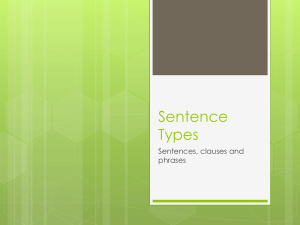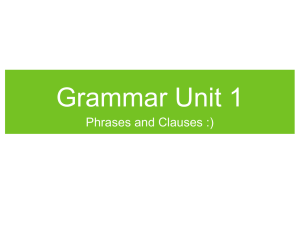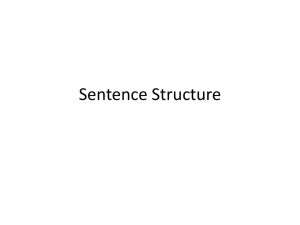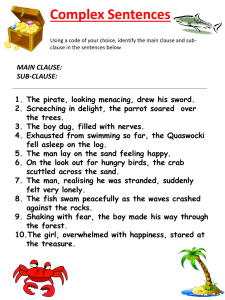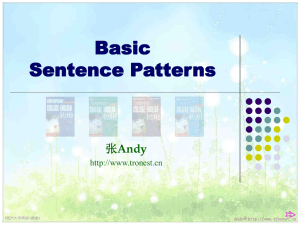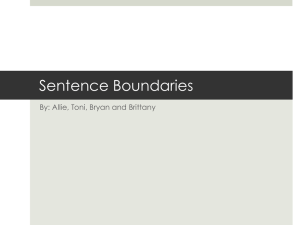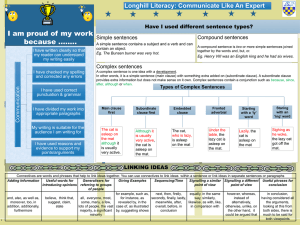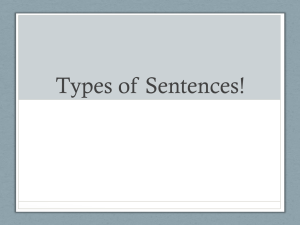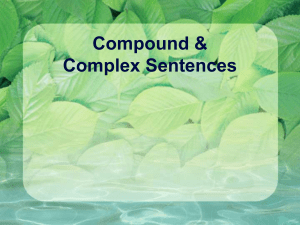Grammar for Grade 9 IV Clauses and Sentence
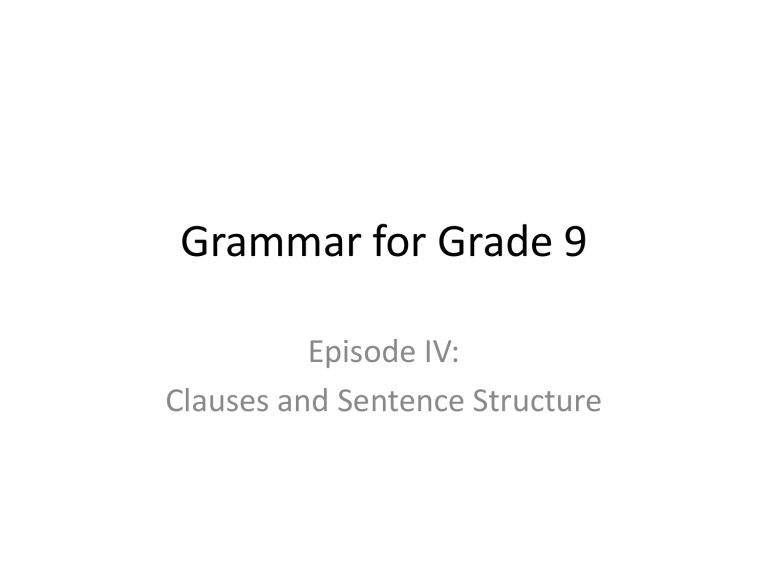
Grammar for Grade 9
Episode IV:
Clauses and Sentence Structure
Four Types of Sentences
• There are four types of sentences:
– Declarative sentences, or statements
– Interrogative sentences, or questions
– Imperative sentences, or commands
– Exclamatory sentences, or exclamations
Declarative Sentences
• End with a period, sometimes called a “full stop”
• State facts or opinions and can be long or short
• Most sentences are declarative. For example:
– I have never eaten kohlrabi.
– Although Thomas is older than Eileen, she is taller than he is.
– Going to the library is more fun than going to the beach.
Interrogative Sentences
• End with a question mark: ?
• Generally employ an interrogative word (who, what, when, etc) or verb inversion (“Are you going to sit?” instead of “You are going to sit.”
• Examples:
– Why don’t you sit down?
– What were you doing out so late?
– Did you think you were going to get away with this?
– Are you going to cry?
Imperative Sentences
• Make a command or request and end with a period.
– Brian, close the door.
• May not have an expressed subject. Since the speaker is commanding “you” to do something, the understood subject is “you”.
– Close the door.
• While the sentence doesn’t say who is supposed to do the closing, the subject is “you”: whoever the speaker is talking to.
Exclamatory Sentences
• Express strong emotion, or powerful feelings.
• End with an exclamation mark: !
• Never use more than one exclamation mark
(or a mixture of exclamation and question marks) in formal writing.
– I’m leaving!
– We beat the other team 24-7!
– Get out of here!
• Notice that this is also an imperative sentence...it’s an order that is being expressed with strong emotion.
Fragments (Sentence Error)
Sentence fragments
– Are incomplete sentences that are punctuated as though they are complete.
– Can be missing a subject, verb, or complete thought.
– Examples:
• Ran quickly to the store.
• Bob and Louis in the ballpark at noon
• Even though I told them not to.
Run-On (Sentence Error)
• The most common sentence error, run-on sentences happen when more than one complete thought is punctuated as though it was only one sentence.
• Example:
– He ate lunch I didn’t.
Run-Ons (Continued)
• Comma splices are a special type of run-on. They happen when two sentences are joined together with just a comma.
• Example:
– It has been such a long time, I can’t tell you how glad I am to see you.
• Run-ons also happen if the comma before a coordinating conjunction that joins together two main clauses is left out.
• Example:
– Burkina Faso is its new name but many books still list it by its old name of Upper Volta.
Sentence Errors
• Professional writers sometimes use fragments and/or run-on sentences for effect. However, you should avoid them.
• Your teacher will likely assume that you didn’t notice them, and your grades might suffer.
Clauses
• A clause is a group of words which has a subject and a verb.
• If the clause can stand on its own as a sentence (if it contains a complete thought), it is called an independent clause.
• Examples:
– I told you we’d win the game!
– Grammar really isn’t that hard.
Clauses II
• A clause which does not contain a complete thought is called a dependent clause.
• Dependent clauses usually have a subordinating conjunction to make them dependent.
• Examples:
– Although I told you we’d win the game
– Since grammar isn’t that hard
Clauses and Sentence Errors
• Students often put a period at the end of a dependent clause, which results in a fragment error. Don’t.
• Other times, they put two independent clauses together and create run-ons. Avoid this, too.
Sentence Structure
• There are four ways to put a sentence together. From least complicated to most complicated, they are
– Simple sentences
– Compound sentences
– Complex sentences
– Compound-complex sentences
Simple Sentences
• Simple sentences have one main clause.
• Examples:
– The dog bit the trainer.
– The dog and the cat bit the trainer.
• Simple sentence with compound subject
– The dog bit and scratched the trainer.
• Simple sentence with compound predicate
– The mangy dog and the scruffy, yowling cat viciously bit and scratched the cruel, underpaid trainer.
• Expanded simple sentence with compound subject, compound predicate and modifiers
Compound Sentences
• A compound sentence has two or more main clauses, joined by a coordinating conjunction or a semicolon.
• Examples:
– The dog bit, but the cat scratched.
– The dog bit; the cat scratched.
Complex Sentences
• A complex sentence has one main
(independent) clause, and a subordinate
(dependent) clause connected to it.
• These clauses must be connected correctly.
Follow the Isadora Duncan rule.
– Duncan, Isadora [If the dependent clause is first, use a comma between it and the independent clause.]
– Isadora Duncan [There is no comma between the clauses when the independent clause is first.]
Compound-Complex Sentences
• These are sentences which have both subordinate clauses AND more than one independent clause.
• Example:
– While I was pulling out to drive to the beach , I accidentally hit the recycling bin at the end of my driveway , but I didn’t do any damage to my car.
– Green: subordinate clause, blue: independent clause, red: second independent clause with coordinating conjunction.
Adjectival Clauses
• An adjectival (or adjective) clause modifies a noun or a pronoun, so the whole clause functions like an adjective.
• It normally follows the word it modifies.
• An essential, or restrictive clause is one that is necessary for the meaning of the sentence.
– The person who parked in the driveway should move the car immediately.
Adjectival Clauses II
• A nonessential, or nonrestrictive clause contains information that is not necessary for the meaning of the sentence.
• These adjective clauses are set off with commas.
– Katmandu, which is the capital of Nepal, is the home of many famous temples.
Adverbial Clauses
• Adverbial, or adverb clauses, modify verbs, adjectives or adverbs, and are introduced by subordinating conjunctions, such as since when although wherever because after before while whenever
• An adverb clause with some words left out is called elliptical. The omitted words can easily be filled in because they are implied.
– I have never heard a better pianist than she [is].
Noun Clauses
• Noun clauses can perform any function that nouns can perform.
– Whoever can sing well may try out for the part.
• Subject
– She couldn’t decide which she liked best.
• Direct object
– The argument caused a misunderstanding about
when the lights should have been turned off.
• Object of a preposition
• Sometimes the relative pronoun used to introduce a noun clause is omitted.
– I believe [that] the wallet belongs to you.
